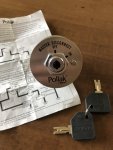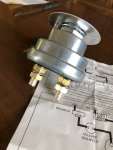I try to get one's thinker going.

AND note everyone has their own way to skin the cat.
Pencil and paper time.


Draw out the two batteries. show the front +24 volts going to the truck, the - & + strapping the two together the placement of the switch on the - ground rear battery. GOOD. Move to the front of the class. No copying!
Yes, we / most can do this in our head. You got your back battery and it's ground post is connected to the shunt and down to the real ground stud which is on the starter frame bolted to the engine. SO far so good and for simplicity sake GROUND, breaking that back battery ground with the disconnect breaks the ground and all is good. This set up removes both batteries from providing 24 volts to your rig. (providing NO wonky 12 volt tap to run your 12 volt stuff) Security or safety switch all GOOD.
Where it get sideways is those making connections to the 12 Volt connection to run 12 volt equipment. If you OPEN the ground with the disconnect switch, the ground potentially now moves up to the front battery thru your 12 volt equipment. Draw that connection

With the switch OPEN in the disconnected security / safety position AND any attempt to pull a load on the 24 volts leg...say try and start, turn on the lights... the front + 12 volt battery will be the source (can't be 24 volts, the back was disconnected, right), so front -12 volt battery becomes the return or ground thru your 12 volt equipment. This configuration will likely damage the 12 volt equipment. This is the sneak - current not anticipated or a false ground return. Good chance the equipment becomes the "fusible link" and poof.
You could do the disconnect on the positive + 24 volts lead. Again a bad idea should you leave the 12 volt gear on. Now a dead rear battery requiring charging the dead and then balancing the two. BIG pain in the butt. 60 Amp dudes, raise your hand if your arm pressing - swapping batteries to keep the 12 volts stuff working. Trying to run a QUALITY, reliable 12 volt feed using the 60 Amp system above is problematic.
I too have the 60 amp alternator set up. (and lots of radios) Your choice to use a 24 to 12 volt converter is the way to go (proper capacity/rating). Even better, one that is a battery equalizer. This way at least the two batteries are seeing a balanced charging / discharging condition.
Sure, BEST would be the 200 Amp alternator with the 14 volt regulator connection to batteries. To switch up could be the cats meow and big $$$.
I went with the Eaton Sure Power 100 Amp equalizer with excellent results and IMO the best answer to 60 Amp operators. Almost plug and play.
New in the box cheap. Go with what you got, CAMO






